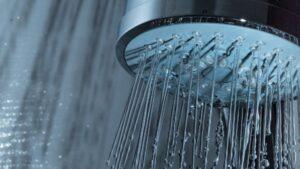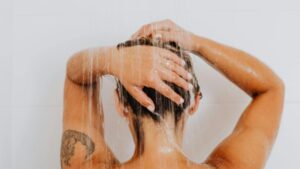You step into your shower for a refreshing start to your day, but then you see it – ugly black or greenish spots on your shower head. It’s a common problem, but that doesn’t make it any less gross. A moldy can pose pose potential health risks.
In this post, we’ll walk you through why mold appears on your shower head, and how to clean it away safely. We’ll also share some simple tips to prevent it from coming back.
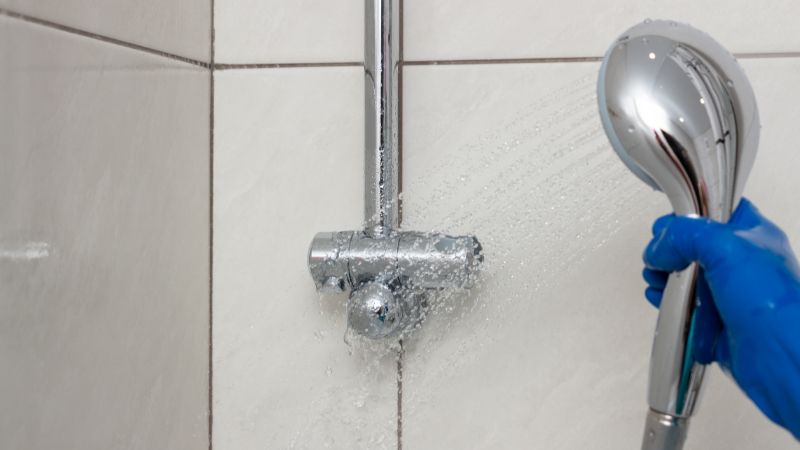
What Causes Mold on a Shower Head?
Your bathroom is the perfect breeding ground for mold. It’s warm, damp, and often dark – everything mold needs to thrive. Here’s a closer look at the culprits behind your moldy shower head:
- Constant Moisture: Every time you take a shower, you’re creating a humid environment. Water gets trapped in the nozzles and crevices of your shower head, providing the moisture that mold loves.
- Soap Scum and Body Oils: The residue from your soap, shampoo, and body oils can build up on your shower head over time. This grime is a food source for mold, encouraging it to grow and spread.
- Mineral Deposits: If you live in an area with hard water, you’re probably familiar with limescale – that chalky white substance that builds up on your fixtures. These mineral deposits not only clog your shower head but also create a porous surface where mold can easily take hold.
- Poor Ventilation: A steamy bathroom without proper airflow is a recipe for mold. If you’re not using an exhaust fan or opening a window after you shower, you’re trapping that moist air inside, creating a haven for mold to flourish.
What Kind of Mold is in Your Bathroom Showers?
Black mold is the most recognizable type that appears on shower heads. This dark-colored growth often indicates long-term moisture exposure and poor ventilation.
Red mold frequently develops on shower heads in homes with hard water issues. The mineral deposits create an ideal surface for this particular mold variety to establish itself.
Green and white mold also appear on shower fixtures. These lighter-colored growths can be just as problematic as their darker counterparts.
The type of mold that develops depends on several factors:
- Water quality and mineral content
- Temperature fluctuations
- Available nutrients from soap residue
- Duration of moisture exposure
Each mold type requires slightly different cleaning approaches. However, all varieties share the same basic need for moisture and organic matter to survive and multiply.
Is a Moldy Shower Head a Health Risk?
For most people, a little bit of mold on the shower head won’t cause any serious harm. However, for individuals with allergies, asthma, or a compromised immune system, mold exposure can be a real problem. Inhaling mold spores can trigger allergic reactions, asthma attacks, and other respiratory issues.
Some shower heads can even harbor harmful bacteria like Mycobacterium avium, which can cause lung infections in susceptible individuals. And that black mold you see? It could be Stachybotrys chartarum, a type of mold that can produce mycotoxins, which can be harmful if inhaled.
Even if the mold on your shower head is just harmless mildew, it’s still a good idea to remove it. A clean shower head is a healthy shower head.
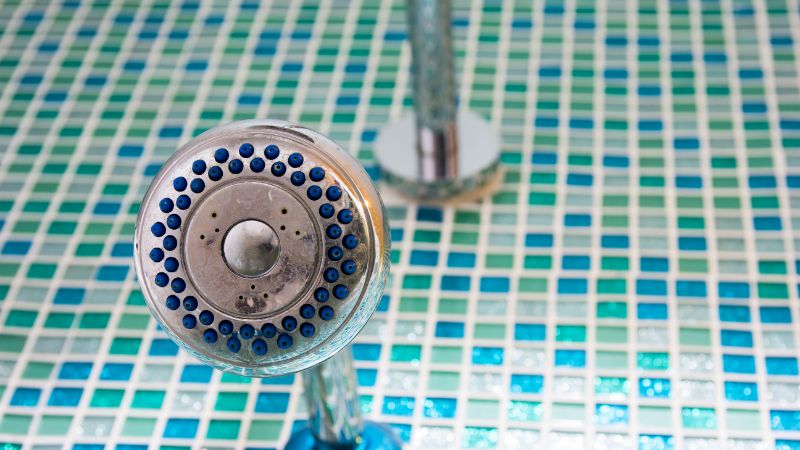
How to Tell if You Have Mold in Your Shower Head
Not sure if you’re dealing with mold? Here are a few tell-tale signs:
- Visible Spots: Look for black, green, or pinkish-orange spots or patches on the surface of your shower head.
- Musty Odor: Mold has a distinct musty, earthy smell. If you notice an unpleasant odor coming from your shower, it could be a sign of mold.
- Check Inside: To get a better look, unscrew your shower head from the pipe. You might be surprised to find mold growing on the inside.
6 Steps to Clean Mold in Showers
Ready to tackle that mold? Here’s a simple and effective cleaning method using household ingredients:
Step 1: Gather Your Supplies
You’ll need:
- White vinegar
- Baking soda
- An old toothbrush
- A soft cloth
- A bucket or a sturdy plastic bag
- A wrench or pliers (if needed)
Step 2: Remove the Shower Head
For a thorough cleaning, it’s best to remove the shower head. Most shower heads can be unscrewed by hand. If it’s on tight, use a wrench or pliers to loosen it, but be sure to wrap a cloth around the fixture to prevent scratching.
Step 3: Soak the Shower Head
You have two options for this step:
- The Bucket Method: Fill a bucket with equal parts white vinegar and warm water. Submerge the shower head in the solution and let it soak for at least 30 minutes. For heavy buildup, you can soak it overnight.
- The Plastic Bag Method: If you can’t remove your shower head, fill a plastic bag with the vinegar solution and secure it over the shower head with a rubber band. Make sure the nozzles are completely submerged.
Step 4: Scrub Away the Grime
After soaking, use an old toothbrush to scrub the shower head, paying close attention to the nozzles. For stubborn clogs, you can use a toothpick or a paperclip to gently poke out any remaining debris.
Step 5: Rinse and Reassemble
Rinse the shower head thoroughly with warm water. If you removed it, now is the time to reattach it.
Step 6: Run Hot Water
Turn on your shower and let hot water run for a few minutes to flush out any lingering vinegar or debris.
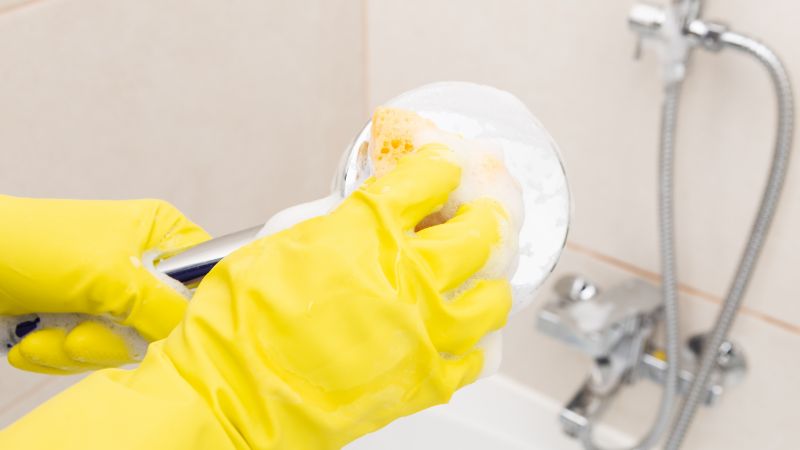
How to Prevent Mold on Your Shower Head
Now that your shower head is sparkling clean, let’s keep it that way. Here are some simple tips to prevent mold from coming back:
- Improve Ventilation: This is the most important step. Always use your exhaust fan when you shower, and leave it on for at least 30 minutes afterward. If you don’t have a fan, open a window or use a dehumidifier to reduce the humidity in your bathroom.
- Dry Your Shower: After each use, take a minute to wipe down the shower walls and your shower head with a squeegee or a towel. This will remove the excess moisture that mold needs to grow.
- Regular Cleaning: Make it a habit to clean your shower head every few weeks. A quick scrub with a brush can go a long way in preventing mold buildup.
- Use Mold-Resistant Products: When it’s time to replace your shower curtain or re-caulk your shower, look for products that are specifically designed to resist mold and mildew.
- Consider a New Shower Head: If your shower head is old and constantly getting moldy, it might be time for an upgrade. Many new shower heads are designed with antimicrobial materials that help prevent mold growth.
When to Call a Professional
While the DIY vinegar soak is effective for most situations, some problems require an expert. You should consider calling a professional plumber or mold remediation specialist if:
- The mold problem is widespread and appears on your bathroom walls or ceiling.
- Mold returns very quickly after cleaning, which could signal a hidden leak or a larger ventilation issue.
- You or your family members are experiencing ongoing health symptoms that you suspect are linked to mold.
Enjoy a Cleaner, Healthier Shower: Leelongs Shower Solutions
A moldy shower head is a common household nuisance, but it’s one you can easily control.
While regular cleaning is essential, taking a proactive step to prevent the buildup that encourages mold in the first place is an even more effective strategy. By improving the quality of your shower water, you create an environment where mold, mildew, and grime struggle to form.
Filtered Shower Heads
To combat the root causes of mold buildup, such as mineral deposits and soap scum, consider upgrading to a filtered shower head. Leelongs offers a variety of filtered shower heads that not only help prevent mold but also improve your skin and hair health by removing chlorine and other impurities from the water.
Here are a few top recommendations:
- 5 Modes Filter Shower Head with Extra Filter Replacement (SH-2866): Special Filter Beads in the shower head can make up multi-layer filter system, which can remove excess impurities, and soften hard water.
- Ultimate Best Showerhead with Filter for Refreshing Showers (SH-30021): Designed for a superior shower experience, this model effectively filters out impurities to soften hard water, and keep water’s PH Balance.
- 5.5″ Rainfall Filtered Showerhead for Hard Water with 7 Spray Settings (SH-30020): If you have hard water, this rainfall showerhead is an excellent choice. Its 8-stage filter is specifically designed to tackle mineral deposits that contribute to mold growth.
Stylish and Easy-to-Clean Shower Sets
For an extra layer of protection, consider a shower head with self-cleaning nozzles to prevent build up and bacteria for a hygienic and powerful wash. If you’re considering a complete bathroom upgrade, a new shower set can make a significant difference. Leelongs offers a wide range of stylish shower sets that are not only aesthetically pleasing but also designed for easy maintenance.
By choosing the right shower products, you can effectively address the issues of mold and create a cleaner, more enjoyable shower environment.

